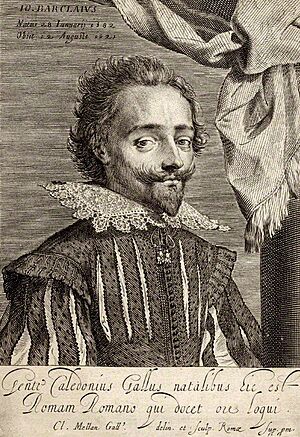John Barclay (poet) facts for kids
Quick facts for kids
John Barclay
|
|
|---|---|

John Barclay by Claude Mellan
|
|
| Born | 28 January 1582 Pont-à-Mousson, Lorraine, Kingdom of France
|
| Died | 15 August 1621 (aged 39) |
| Nationality | Scottish |
| Occupation | writer |
|
Notable work
|
Argenis |
John Barclay (born January 28, 1582 – died August 15, 1621) was a Scottish writer. He was known for his clever satires and Latin poems. He wrote in a style called Neo-Latin, which means he used Latin like the ancient Romans did.
Contents
John Barclay's Early Life and Education
John Barclay was born in Pont-à-Mousson, a town in Lorraine, France. His father, William Barclay, was Scottish. He was a professor of civil law, which is a type of legal system. John's mother was French.
John went to the Jesuit College in Pont-à-Mousson for his early education. When he was just nineteen years old, he wrote a detailed explanation of a famous Latin poem. This poem was called Thebaid by Statius.
Moving to England and Early Writings
The Jesuits, a religious order, wanted John to join them. However, his father did not agree. So, in 1603, his father took him to England. John always felt very Scottish, even though he grew up in France. He saw a good chance when James VI and I became king of England.
In early 1604, John Barclay gave King James a Latin poem. He later dedicated the first part of his book, Euphormionis Satyricon, to the king. This book was a satire, meaning it used humor to criticize the Jesuits.
Life in France and London
By 1605, John had returned to France. He spent some time in Angers. A second edition of his book, Euphormionis Satyricon, was published in Paris that year. John was married to a French woman named Louise Debonaire.
John and his wife moved back to London in 1606. There, he published Sylvae, which was a collection of Latin poems. In 1607, the second part of his Satyricon was released in Paris.
Later Years in Rome
In 1616, John Barclay moved to Rome and lived there until he died. He passed away on August 15, 1621, when he was 39 years old. He might have left England because he wanted his children to be raised as Catholics. His children were born in England, and he did not want them to be raised as Protestants.
He also might have been looking for a more generous supporter than King James, who was not known for being very giving. In fact, John Barclay received money from the Pope, which was about 150 pounds a year.
While in Rome, he wrote his most important novel, Argenis. People at the time said he also enjoyed gardening. He was part of several smart and literary groups in Rome, including the Accademia dei Lincei. His wife lived longer than him and died in 1652. One of his sons later became a bishop in France.
John Barclay's Published Works
In 1609, John Barclay helped publish De Potestate Papae. This was a book written by his father, who had died the year before. The book was against the power of the Pope.
In 1611, John released Apologia, which was like a "third part" of his Satyricon. He wrote it to respond to criticisms from the Jesuits. A "fourth part" came out in 1614. It was called Icon Animorum and described the personalities and customs of different European nations.
John seemed to have a better relationship with the Church later on. In 1617, he published Paraenesis ad Sectarios from a printer in Rome. This book criticized Protestantism. Later versions of this book were printed in Cologne.
His Most Famous Novel: Argenis
The most important work John wrote in his final years was Argenis. This was a political romance novel. It was similar in some ways to Arcadia by Philip Sidney and Utopia by Thomas More.
He finished the book about two weeks before he died. Argenis became his most famous work.
See also
 In Spanish: John Barclay para niños
In Spanish: John Barclay para niños

